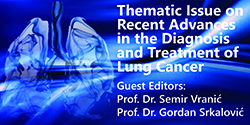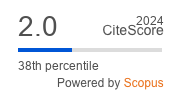Artificial neural network in prediction of the outcome of critically ill patients with perforative peritonitis
Keywords:
Artificial neural network, Perforative peritonitis, APACHE II, Surgical intensive care unitAbstract
Aim. The aim of the present paper is to compare the use ofArtificial Neural Network (ANN) to APACHE II, MOF, TISS-28 and MPI scoring system in prediction of peritonitis-relateddeath in patients with perforative peritonitis. Patients andmethods. A prospective study was performed of 145 patientswith perforative peritonitis, treated in the Surgical IntensiveCare Unit. The main outcome of this study was peritonitisrelateddeath. The Levenberg-Marquardt method was usedfor training, and 16 variables for entrance into the ArtificialNeural Network. Sensitivity and specificity of scoring systemsare graphically shown for the different values of cut-off pointswith the receiver-operating characteristic curve (ROC) curve.Results. We tested 92 cases in a network and found that theAPACHE II system predicted the lowest number of wrongassessments with a score of 12, with all the other scoringsystems predicting 19 wrong assessments. The area underthe curve for the first postoperative day was 0.87 for TISS-28score, 0.86 for APACHE II score, 0.83 for MOF and 0.72 forMPI score. The highest rate of correlation between the observedand the expected mortality rate was in the APACHEII system. This demonstrated that TISS-28 and APACHE IIare significantly better than other systems (P<0.01). In addition,this discriminatory ability was also retained on the thirdand seventh postoperative days. Conclusion. APACHE II issuperior in the prediction of patient outcome to the ArtificialNeural Network and other tested scoring systems.References
Knauss WA, Drapper EA, Wagner DP, Zimmerman JE. APACHE II. A severity of disease classification system. Crit. Care Med. 1985; 143: 818-29.
Sawyer RG, Rosenlof LK, Adams RB, May AK, Spengler MD, Pruett TL. Peritonitis into the 1990s: changing pathogens and changing strategies in the critically ill. Am Sur g. 1992;58:82-7.
Linder M, Wacha H. Stellenwert von Peritonitis-Indizes fuer die klinischeprognos-tische beurteilung der Peritonitis. Aktuelle Chirurgie. 1992; 27:41-7.
Billing A, Frohlich D, Schildberg FW and the Peritonitis Study Group. Prediction of outcome using the Mannheim peritonitis index in 2003 patients. Br J Surg. 1994;209-13.
Goris RJA, Boekhorst TPA, Nuytinick JKS, Gimbrere JSF. Multiple-organ failure: generalised autodestructive inflammation? Arch Surg 1985; 120:1109-15.
Lefering R. Biostatistical aspects of outcome evaluation using TISS-28. Eur J Surg Suppl. 1999; 584: 5-61.
Wacha H, Linder MM, Feldman U, Wesch G, Gundlach E, Steifensand RA. Mannheim peritonitis index - prediction of risk of death from peritonitis. Construction of a statistical and validation of an empirically based index. Theoretical Surgery
; 1: 169-77.
Clermon G, Angus DC, DiRusso SM, Griffin M, Linde-Zwirble WT. Predicting hospital mortality for patients in the intensive care unit: A comparison of artificial neural networks with logistic regression models. Crit Care Med. 2001;29:291-6.
Jaimes F, Farbiarz J, Alvarez D. Martinez C. Comparison between logistic regression and neural networks to predict death in patients with suspected sepsis in the emergency room. Crit Care. 2005; 9; 150-6.
Bohnen J, Boulanger M, Meakins JI, Mc Lean APH. Prognosis in generalized peritonitis. Relation to cause and risk factors. Arch Surg. 1983; 118: 285-90.
Wittmann DH, Walker AP, Condon RE. Peritonitis and intra-abdominal infection. In: Principles of Surgery, ed. Schwartz, Shires, Spencer. McGraw-Hill, Inc. International edition, 1994;1449-83.
Kulkarni SV, Naik AS, Subramanian N. AAPACHE–II scoring system in perforative peritonitis. Am J Surg. 2007; 194:549-52.
Nimgaonkar A, Karnad DR, Sudarshan S, Ohno- Machado L, Kohane I. Prediction of mortality in an Indian intensive care unit. Comparison between APACHE II and artificial neural networks. Intensive Care Med. 2004;30:248–53.
Demmel N, Muth G, Osterholzer G. Prognosescores bei Peritonits; Mannheimer Peritonitis-Index oder Apache II? Langenbecks Arch Chir. 1994;379:347-52.
Goffi L, Saba V, Ghiselli R, Necozione S, Mattei A, Carle F. Preoperative APACHE II and ASA scores in patients having major general surgical operations: prognostic value and potential clinical applications. Eur J Surg. 1999;165:730-35.
Wickel DJ, Cheadle WG, Mercer-Jones MA, Garrison RN. Poor outcome from peritonitis is caused by disease acuity and organ failure, not recurrent peritoneal infection. Ann Surg. 1997;6:744-56.
Pusajo JF, Bumaschny E, Doglio GR, Cherjovsky MR, Lipinszki AI, Hernandez MS, Egurrola MA. Postoperative intra-abdominal sepsis requiring reoperation. Arch Surg. 1993;128:218-23.
Poses RM, McClish Dk, Bakes C, Scott WE, Morley JN. Ego bias, reverse ego bias, and physicians’s prognostic judgments for critically ill patients: Crit Care Med. 1991;19:1533-9.
Poses RM, Bakes C, Copare F, Scott WE. The answer to “what are my chances, doctor?” depends on whom is asked: Prognostic disagreement and inaccuracy for critically ill patients. Crit Care Med. 1989;17:827-33.
Marks RJ, Simons RS, Blizzard RA, Browne DRG. Predicting outcome in intensive therapy units - a comparison of APACHE II with subjective assesments. Intensive Care Med. 1991;17:159-63.
Ohamnn C, Hau T. Prognostic indices in peritonitis. Hepatogastroenterology. 1997;44:937-46.






